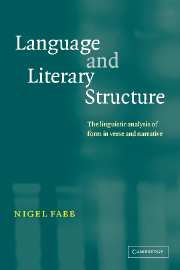3 - Communicated form
Published online by Cambridge University Press: 22 September 2009
Summary
Some kinds of literary form hold systematically of a text; these were the kinds of metrical form examined in chapters 1 and 2. For example, for iambic pentameter lines, there are always ten projected syllables and stress maxima always project to gridline 1; they are instances of invariant form. But many kinds of literary form do not hold fully of the text, and instead are best thought of as holding to a certain extent; these are instances of variable form. In this chapter I show this by looking at ‘being a sonnet’ as a kind of variable literary form and associated kinds of form such as ‘being in lines’, ‘rhyming’ and so on. Because these kinds of form hold to a certain degree rather than holding invariably, they cannot be generated by rule. Instead I suggest that they hold of the text in an entirely different way from the kinds of metrical form discussed in the previous chapters. These variable kinds of form hold of a text only by virtue of being the content of weaker or stronger thoughts about the text. Thus literary form of this kind has no objective existence in the text. This kind of literary form is explained by reference to a theory of thoughts and how thoughts are derived, which is a theory of linguistic pragmatics (specifically, Relevance Theory).
- Type
- Chapter
- Information
- Language and Literary StructureThe Linguistic Analysis of Form in Verse and Narrative, pp. 57 - 87Publisher: Cambridge University PressPrint publication year: 2002



